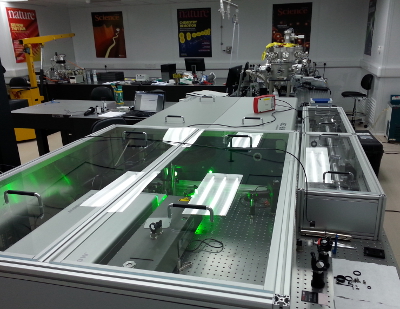Using AI to control energy for indoor agriculture
30 September 2024
Published online 16 March 2015
Researchers at King Saud University in Riyadh will use attosecond laser technology to take a closer look at melanin and how it works.

Courtesy of King Saud University
Attosecond Science Laboratory (ASL) at the King Saud University (KSU) will be the first in the Arab world to use cutting-edge attosecond laser technology able to generate ultrashort pulses of light, lasting just a few billionths of a billionth of a second, that can capture images of otherwise invisible electrons within atoms.
The researchers will first fire a femtosecond laser pulse that simulates sunshine, followed by another probe attosecond pulse to track the effect of the first burst of light on the system. A spectroscopic system will then capture the interaction of light with matter and analyse it.
The lead researcher, Adil Haseeb, wants to better understand the conductivity and photoconductivity responses of melanin in different physical states: solid, paste, and liquid.
“More specifically, how does this molecule prevent UV photons from breaking bonds and changing molecular structure and hence function?” says co-researcher Ferenc Krausz. “Electrons in the melanin molecule have to play a fundamental role in these mechanisms.
He hopes that observing what happens within the molecules will answer these questions.
“Melanin is a well-known organic conductor, and its charge is carried on electrons and protons,” says Haseeb. “We want to find which carrier types dominate at the levels of humidification, and to check the photoconductivity at these various states at different pH levels and metal loading.”
“The short UV pulses generated by femtosecond and asttosecond lasers should help us to unravel some of the details of these mysterious non-destructive melanin high-energy photon interactions, and it may suggest methods for protection against nuclear radiations using an organic material,” adds Haseeb.
The short UV pulses should help us to unravel some of the details of these mysterious non-destructive melanin high-energy photon interactions
The state-of-the-art attosecond beamline can produce intense laser pulses and a well-controlled waveform comprising merely a couple of wave cycles. These pulses, Krausz explains, are focused in a jet of neon gas inside a vacuum chamber.
“The strong electric field of these pulses detach the most weakly bound electron of the atoms, pulling it away from the nucleus and – in the next half cycle – push it back to the vicinity of the nucleus,” he says.
The apparatus can be compared to a hyperfast camera with the ability to take rapid snapshots of the motion of electrons in atomic systems with attosecond resolution.
In the past, the research team at KSU has used standard research equipment, but the new lab will offer local researchers an opportunity to do original and novel research, says Haseeb.
Stephen R. Leone, a researcher from University of California Berkeley, who was not involved in the study says: “Using attoseceond measurements to understand electron dynamics has much promise to address problems in semiconductors and strongly correlated materials as well as charge migration in molecules.”
An independent researcher from the National Research Council of Italy CNR-IFN, Francesca Calegari, who has been working in the attosecond field since 2006, says that attosecond laser sources are attractive in many fields like atomic and molecular physics, condensed matter science and chemistry.
“In the field of photo-chemistry and photo-biology the real breakthrough would be to understand the role of electron dynamics in the photo-chemical processes triggered by the interaction of biomolecules with high-energy photons,” she adds. “It will open new important perspectives in the full understanding of fundamental processes such as DNA damage and photo-protection.”
The team at the ASL is also planning to use the laboratory for further tests on melanin, to glean its role in radiation shielding and its magnetic properties, and to study elementary processes in chemical reactions.
“There are other ultrafast laser laboratories working in the femtosecond regime, but this is the only one with the capability to explore such fast processes – up to 1,000 times faster than what can be currently explored in the Kingdom,” says co-researcher Matthias Kling.
doi:10.1038/nmiddleeast.2015.49
Stay connected: